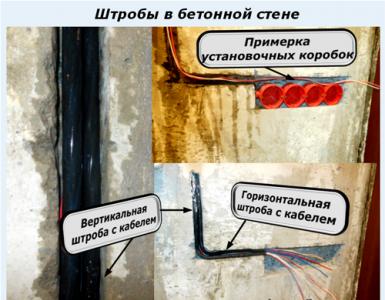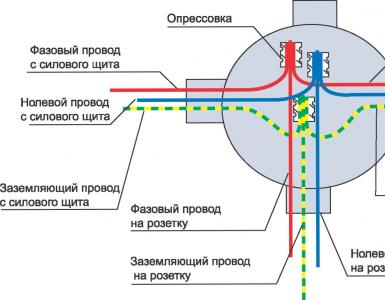Connecting an electrical outlet
1. Turn off the machine. Connecting an outlet is not a difficult job, but do not neglect such things as electrical safety. To do this, remove the voltage from the connected outlet. This can be done by turning off the circuit breakers at the input or by unscrewing the plugs (if used).
2. We check the absence of voltage. Before unscrewing the cover and touching bare wires and contacts with your hands, you must finally make sure that there is no voltage. This can be done with a conventional voltage indicator, indicator or multimeter.
If you decide to replace the outlet with a new one, then you first need to dismantle the old one. To do this, remove the cover, unscrew the screws of the pressing "legs". When the pressing "legs" no longer hold the socket, pull it out of the box and carefully unscrew the power wires.
3. We clean the wire. Before connecting the socket, it is necessary to prepare a wire protruding from the socket. If the laid wire or cable is double insulated (type PVS, ShVVP, VVG), then 15–20 cm of external insulation is removed from it. After that, it becomes more flexible to connect.
If a double wire with single insulation (type PPV) is laid, then it is possible to separate the cores from each other by 5 - 10 cm.
4. We connect a new outlet. First you need to connect the power wire to the contacts. To do this, the insulation is removed from the conductive conductors of the wire by about 5 - 10 mm. The bare part of the wire is inserted into the connection terminal and securely tightened with a screw. When tightening the screw, do not use excessive force, otherwise the wire may be crushed.
There is a "good" and "reliable" wire connection.
With a good connection, the stripped wires are inserted into the terminals and tightened. With a reliable connection, the stripped wires are bent into a ring with a diameter of 4 - 5 mm.
This method of connecting contacts, although it takes more time, however, has several advantages:
- - firstly, the connection is more reliable;
- - secondly, with such a connection, the contact area of the conductive contact with the wire will be larger, therefore, the contact will heat up less.
If the wire is stranded, then it is better to tin it with solder before connecting it.
If produced connection of sockets with grounding, the ground wire is connected to the appropriate terminal - "ground terminal". This terminal is connected to the grounding antennae. Before connecting the grounding conductor of the wire, you must make sure that this particular conductor is the grounding conductor.
5. Installing the socket in the socket. After connecting all the supply wires, you need to install the working part of the socket in the socket. It must be installed exactly without distortions on the same level with the wall. The power wires are neatly hidden in the socket.
When the socket is exposed, it must be securely fixed in this position. To do this, it has special pressing "feet" with screws. By tightening these screws, the “legs” move apart, thereby fixing the socket.
In sockets of the new sample, pressing "legs" are not provided. They are fixed with screws that are located in the socket.
6. We fasten the cover. When the working part of the outlet is securely installed in the socket, you can screw the cover.
How to connect a double socket
Consider an example of connecting a double socket of two types:
- - stationary double;
- - assembled double.
Fixed double socket
For double socket connection it has clip-on contacts. It often happens that a double socket does not have a top or bottom. That is, the contacts for connecting wires to it are located both above and below - two pairs of contacts.

Based on this, we can conclude that you can connect a double outlet "right" and "wrong".
The correct one is to connect the supply wires to different conductive plates.
It is not correct when two supply wires, phase and zero, are connected to one conductive plate. Such a connection is extremely dangerous, since when the machine is turned on, a short circuit will occur, and electrical wiring may be damaged.

Assembled double socket
The term “assembled double” refers to two or more single sockets located side by side.
What to do if you need to connect two sockets, but the power wire is connected to only one socket?

To do this, you need to make a jumper, transfer a piece of wire from the first box to the second and connect all these wires in parallel to each other.














